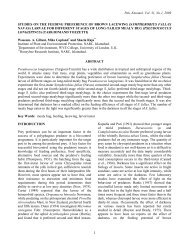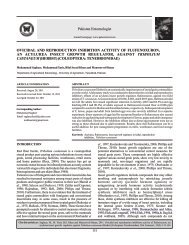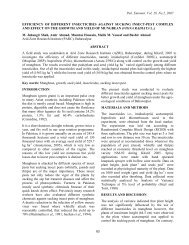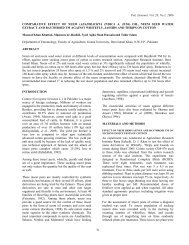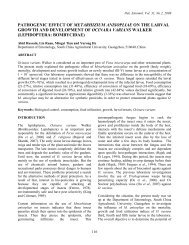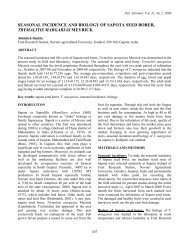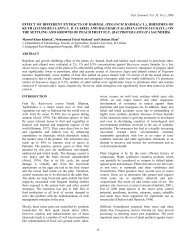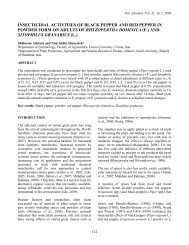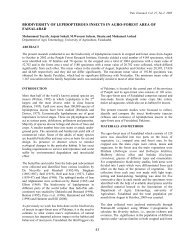mortality responses of spodoptera litura (fab.) (lepidoptera: noctuidae)
mortality responses of spodoptera litura (fab.) (lepidoptera: noctuidae)
mortality responses of spodoptera litura (fab.) (lepidoptera: noctuidae)
You also want an ePaper? Increase the reach of your titles
YUMPU automatically turns print PDFs into web optimized ePapers that Google loves.
Pakistan Entomologist<br />
Journal homepage: www.pakentomol.com<br />
MORTALITY RESPONSES OF SPODOPTERA LITURA (FAB.) (LEPIDOPTERA:<br />
NOCTUIDAE) AGAINST SOME CONVENTIONAL AND NEW CHEMISTRY<br />
INSECTICIDES UNDER LABORATORY CONDITIONS<br />
*<br />
Rashad Rasool Khan, Sohail Ahmed and Shahid Nisar<br />
Department <strong>of</strong> Agri. Entomology, University <strong>of</strong> Agriculture, Faisalabad.<br />
ARTICLE INFORMATION<br />
Received: September 10, 2011<br />
Received in revised form: November 29, 2011<br />
Accepted: December 8, 2011<br />
*<br />
Corresponding Author:<br />
Rashad Rasool Khan<br />
Email: rashad_khan1@yahoo.com<br />
ABSTRACT<br />
The new chemistry and conventional insecticides were evaluated for their efficacy against<br />
the armyworm, Spodoptera <strong>litura</strong> (Fab.) in the laboratory. All the evaluated insecticides<br />
proved toxic for S. <strong>litura</strong> under laboratory conditions, but chlorpyrifos, pr<strong>of</strong>en<strong>of</strong>os,<br />
emamectin benzoate, spinosad, indoxacarb, methoxyfenozide and lufenuron proved highly<br />
toxic as the exposure time was extended. After 3 days <strong>of</strong> the insecticide treatment, 100%<br />
<strong>mortality</strong> was observed in emamectin benzoate @ 100 and 110 ml/acre treatment, followed<br />
by chlorpyrifos @ 1100 ml/acre (96.56%), leufenuron @ 55 ml/acre (86.67%) and methomyl<br />
@ 440 ml/acre (83.34%). However, chlorpyrifos and emamectin benzoate, at all the three<br />
doses, leufenuron at the higher and recommended dose and thiodicarb, spinosad and<br />
methoxyfenozide, at higher doses, were ranked highly toxic-as these insecticides caused the<br />
highest <strong>mortality</strong> (>90%) in S. <strong>litura</strong>.<br />
Keywords:<br />
Mortality response, Spodoptera <strong>litura</strong>, conventional insecticides, new chemistry<br />
insecticides, laboratory conditions.<br />
INTRODUCTION strategy in case <strong>of</strong> the insects (Denholm and Rowland, 1992).<br />
This tactic has not yet been tested on the field collected<br />
Armyworm (Spodoptera spp., Lepidoptera: Noctuidae) have resistant populations <strong>of</strong> Spodoptera spp.<br />
attained the status <strong>of</strong> the primary insect pest <strong>of</strong> cotton in The present studies report the comparative efficacy <strong>of</strong><br />
Pakistan (Ahmad et al., 2007a). Besides cotton, it also attacks pr<strong>of</strong>en<strong>of</strong>os (Curacron® 50EC), chlorpyrifos (Lorsban®<br />
on tobacco and crucifers (Hussain and Shah, 1998; Ghaffar et 40EC), methomyl (Lannate® 40SP), thiodicarb (Larvin®<br />
al., 2002; Saeed et al., 2010). Spodoptera exigua and S. <strong>litura</strong> 80DP), lufenuron (Match® 5EC), abamectin (Agrimec®<br />
are important species prevalent in cotton crop.<br />
1.8EC), emamectin benzoate (Proclaim® 1.9EC), spinosad<br />
The insecticides used for the control <strong>of</strong> armyworms includes (Tracer® 24SC), indoxacarb (Steward® 15EC) and<br />
conventional (OPs, permethrin, cypermethrin, deltamethrin, methoxyfenozide (Runner® 24SC) at 10% low and high<br />
cyhalothrin etc.) and new chemistry insecticides which have recommended field dose rate against Spodoptera <strong>litura</strong>.<br />
become in effective (Ahmad and Arif, 2009; Ahmad et al.,<br />
2007b; Saleem et al., 2008; Shad et al., 2010). MATERIALS AND METHODS<br />
In order to mitigate insecticide resistance, several strategies<br />
have been suggested and tested in the field and these novel Insects<br />
strategies must be verified with economic and pest control<br />
data to convince farmers (Gressel et al., 1996). With such The full grown larvae <strong>of</strong> S. <strong>litura</strong> were collected from the<br />
tactics, resistance may be minimized or delayed by preserving cotton crop and were reared at 30±2°C and 65±5% R.H. with<br />
a sufficient population <strong>of</strong> susceptible individuals through the light: darkness ratio <strong>of</strong> 14:10 hrs on a semi-synthetic diet<br />
use <strong>of</strong> lower rates <strong>of</strong> given pesticides and avoid the selection (Ahmad et al., 2005).<br />
<strong>of</strong> recessively resistant heterozygotes. On the other hand, use<br />
<strong>of</strong> high dose is also recommended but as means <strong>of</strong> eliminating Insecticides<br />
or reducing frequency <strong>of</strong> heterozygote where resistance is<br />
dominant (NRC, 1986). A number <strong>of</strong> studies have been The recommended insecticides against Spodoptera <strong>litura</strong> on<br />
conducted in this regards with fungicides and rodenticides, a cotton crop in Pakistan were selected for the experimentation.<br />
few were related to managing the resistance by low/high dose The insecticides viz., pr<strong>of</strong>en<strong>of</strong>os (Curacron® 50EC),<br />
Cite this article as: Khan, R.R., S. Ahmed and S. Nisar, 2011. Mortality <strong>responses</strong> <strong>of</strong> Spodoptera <strong>litura</strong> (Fab.) (Lepidoptera: Noctuidae) against some<br />
conventional and new chemistry insecticides under laboratory conditions. Pak. Entomol., 33(2): 147-150.<br />
147
Khan et al. / Pakistan Entomologist 2011, 33(2): 147-150<br />
chlorpyrifos (Lorsban® 40EC), methomyl (Lannate® 40SP), level <strong>of</strong> resistance was found in Spodoptera exigua against<br />
thiodicarb (Larvin® 80DP), lufenuron (Match® 5EC), chlorpyrifos.<br />
abamectin (Agrimec® 1.8EC), emamectin benzoate All the larvae treated with the recommended and higher dose<br />
(Proclaim® 1.9EC), spinosad (Tracer® 24SC), indoxacarb rates <strong>of</strong> methomyl were found dead after 7 days <strong>of</strong> its<br />
(Steward® 15EC) and methoxyfenozide (Runner® 24SC) application whereas 83.34 % <strong>mortality</strong> was observed after 7<br />
were obtained in the form <strong>of</strong> their commercial formulations days when the larvae were treated with its lower dose rate<br />
from the respective manufacturers. Three doses for each (360 g/acre). The higher dose rate (440 g/acre) <strong>of</strong> thiodicarb<br />
insecticide i.e., the recommended dose against S. <strong>litura</strong> and<br />
th<br />
caused 93.34 % <strong>mortality</strong> at the 7 day <strong>of</strong> treatment<br />
10% below and above the recommended dose rate, were application and the recommended and lower dose rates (400<br />
prepared in an Analar grade Acetone. A control treatment <strong>of</strong> and 360 g/acre) caused 80 and 73.32 % <strong>mortality</strong>,<br />
acetone/distilled water applications was also included, for respectively.<br />
each test, to assess the natural <strong>mortality</strong> rates <strong>of</strong> the test insect Among the new chemistry insecticides, lowest <strong>mortality</strong><br />
species. (53.31%) was found in abamectin (180 ml/acre) even after 7<br />
days <strong>of</strong> its application; however, the <strong>mortality</strong> increased with<br />
Bioassay<br />
an increase in the dose rate. The higher dose rates <strong>of</strong> spinosad<br />
(44 ml/acre) caused 93.33% <strong>mortality</strong> after 7 days, but its<br />
Ten larvae <strong>of</strong> S. <strong>litura</strong> (3rd instar), <strong>of</strong> uniform age, were recommended dose (40 ml/acre) caused 86.66% <strong>mortality</strong> <strong>of</strong><br />
exposed to three different concentrations <strong>of</strong> insecticides, the S. <strong>litura</strong> larvae.<br />
using a leaf-dip technique, as recommended by the After 7 days <strong>of</strong> application, the larval <strong>mortality</strong> reached up to<br />
Insecticides Resistance Action Committee (IRAC) <strong>of</strong> GIFAP 83.34% in the larvae treated with higher dose rate <strong>of</strong><br />
(Anonymous, 1990). Unsprayed cotton leaves, were collected indoxacarb (110 ml/acre). Almost the same <strong>mortality</strong><br />
from the field, washed and dipped into the insecticide (83.33%) was observed after 7 days <strong>of</strong> treatment with<br />
(Treatment) solutions, for ten seconds, with a gentle agitation methoxyfenozide (100 ml/acre) and when the dose was<br />
and dried on the tissue papers. The dried leaves were then increased to 110 ml/acre, the <strong>mortality</strong> was 93.23% after 7<br />
placed in the petri dishes having a moist filter paper, in order days <strong>of</strong> application.<br />
to avoid any desiccation. The treatments were observed, after Insecticides like, chlorpyrifos, emamectin benzoate at all<br />
3 and 7 days for their effects. The effects <strong>of</strong> test insecticides three dose rates, lufenuron-at higher and recommended dose<br />
were judged on the basis <strong>of</strong> insect <strong>mortality</strong> levels, after rates and thiodicarb, spinosad and methoxyfenozide-at higher<br />
certain time periods. The data were analyzed statistically at dose rates, were ranked highly toxic, as maximum <strong>mortality</strong><br />
5% level <strong>of</strong> probability using Duncan's Multiple Range Test levels were observed in chlorpyrifos @ 900, 1000 and 1100<br />
and the insecticides were categorized on the basis <strong>of</strong> ml/acre, methomyl @ 400 and 440 g/acre, lufenuron @ 50 and<br />
percentage <strong>mortality</strong>, as; Harmless (90% <strong>mortality</strong>) (Khan, lufenuron @ 45 ml/acre, spinosad @ 44 ml/acre and<br />
2010, unpublished data). methoxyfenozide @ 110 ml/acre, after 7 days <strong>of</strong> the<br />
treatments. Same results were reported by Sparks et al. (1996)<br />
RESULTS AND DISCUSSION<br />
for spinosad and emamectin benzoate as well as by<br />
Mascarenhas et al. (1996) for chlorpyrifos and spinosad. The<br />
The data regarding the percentage-<strong>mortality</strong> <strong>of</strong> the larvae <strong>of</strong> results <strong>of</strong> present study are also confirmatory to those <strong>of</strong><br />
Spodoptera <strong>litura</strong> after 3 and 7 days <strong>of</strong> the insecticide Adamczyk et al., (1999) who reported that the novel<br />
treatments were found significantly different (Table 1). It is insecticides like chlorfenapyr, methoxyfenozide, spinosad<br />
obvious from the data that 100% <strong>mortality</strong> was observed after and tebufenozide were more effective to the pest. The results<br />
3 days <strong>of</strong> treatment application with emamectin benzoate at regarding the indoxacarb in our experiment, were also<br />
the dose rate <strong>of</strong> 100 and 110 ml/acre. While complete comparable to those <strong>of</strong> Hammes et al. (1998) who reported it<br />
<strong>mortality</strong> <strong>of</strong> the larvae was observed after 7 days <strong>of</strong> treatment very effective against S. <strong>litura</strong> and safe to many beneficial<br />
application when larvae were treated at the dose rate <strong>of</strong> 90 insects. The results can also be compared with those <strong>of</strong> Ahmad<br />
ml/acre <strong>of</strong> emmamectin benzoate. The <strong>mortality</strong> was also and Saleem (2004) who reported that amongst new chemistry<br />
found to be 100% after 7 days <strong>of</strong> application at all the dose insecticides, emamectin benzoate and lufenuron resulted in<br />
rates <strong>of</strong> lufenuron. The higher dose rate <strong>of</strong> chlorpyrifos (1100 maximum <strong>mortality</strong> <strong>of</strong> S. <strong>litura</strong>. Ahmad et al., (2005) also<br />
ml/acre) also proved highly toxic as 96.56 % <strong>mortality</strong> was reported that emamectin benzoate proved to be the best<br />
observed in the treated larvae after 3 days. The <strong>mortality</strong> <strong>of</strong> the insecticide followed by lufenuron, spinosad and indoxacarb,<br />
larvae reached 100% after 7 days in all the treatments <strong>of</strong> respectively in their time-oriented <strong>mortality</strong> at three<br />
chlorpyrifos. However, the lower dose rate <strong>of</strong> pr<strong>of</strong>en<strong>of</strong>os (450 concentration levels against S. <strong>litura</strong>; however, abamectin<br />
ml/acre) proved slightly toxic as the treatments caused 66.67 proved to be the least effective to control this pest.<br />
% <strong>mortality</strong> even after 7 days <strong>of</strong> its application. The results These results also support our findings. The overall results <strong>of</strong><br />
documented by Ahmad and Arif (2009) are in partial this study suggest emamectin benzoate as the best insecticide<br />
agreement with our findings. They reported very low or no along with other new chemistry insecticides a long- lasting<br />
resistance in Earias vittella to emamectin benzoate and control tactic for the farming community against S. litua.<br />
pr<strong>of</strong>en<strong>of</strong>os. Ahmad and Arif (2010) reported that very low Lufenuron, indoxacarb, methoxy fenozide and spinosad also<br />
Cite this article as: Khan, R.R., S. Ahmed and S. Nisar, 2011. Mortality <strong>responses</strong> <strong>of</strong> Spodoptera <strong>litura</strong> (Fab.) (Lepidoptera: Noctuidae) against some<br />
conventional and new chemistry insecticides under laboratory conditions. Pak. Entomol., 33(2): 147-150.<br />
148
Khan et al. / Pakistan Entomologist 2011, 33(2): 147-150<br />
proved to be the effective insecticides after emamectin, respectively.<br />
Table. 1<br />
Percentage <strong>mortality</strong> (means±SE) <strong>of</strong> Spodoptera <strong>litura</strong> after 3 and 7 days <strong>of</strong> the insecticide applications.<br />
Treatments Insecticides Dose<br />
(g or ml /acre)<br />
T1<br />
T2<br />
T3<br />
T4<br />
T5<br />
T6<br />
T7<br />
T8<br />
T9<br />
T10<br />
T11<br />
T12<br />
T13<br />
T14<br />
T15<br />
T16<br />
T17<br />
T18<br />
T19<br />
T20<br />
T21<br />
T22<br />
T23<br />
T24<br />
T25<br />
T26<br />
T27<br />
T28<br />
T29<br />
T30<br />
Pr<strong>of</strong>en<strong>of</strong>os (Curacron 50EC)<br />
Pr<strong>of</strong>en<strong>of</strong>os (Curacron 50EC)<br />
Pr<strong>of</strong>en<strong>of</strong>os (Curacron 50EC)<br />
Chlorpyrifos (Lorsban 40EC)<br />
Chlorpyrifos (Lorsban 40EC)<br />
Chlorpyrifos (Lorsban 40EC)<br />
Methomyl (Lennate 40SP)<br />
Methomyl (Lennate 40SP)<br />
Methomyl (Lennate 40SP)<br />
Thiodicarb (Larvin 80DP)<br />
Thiodicarb (Larvin 80DP)<br />
Thiodicarb (Larvin 80DP)<br />
Lufenuron (Match 5EC)<br />
Lufenuron (Match 5EC)<br />
Lufenuron (Match 5EC)<br />
Abamectin (Agrimec 1.8EC)<br />
Abamectin (Agrimec 1.8EC)<br />
Abamectin (Agrimec 1.8EC)<br />
Emamectin benzoate (Proclaim 1.9EC)<br />
Emamectin benzoate (Proclaim 1.9EC)<br />
Emamectin benzoate (Proclaim 1.9EC)<br />
Spinosad (Tracer 24SC)<br />
Spinosad (Tracer 24SC)<br />
Spinosad (Tracer 24SC)<br />
Indoxacarb (Steward 15SC)<br />
Indoxacarb (Steward 15SC)<br />
Indoxacarb (Steward 15SC)<br />
Methoxyfenozide (Runner 24SC)<br />
Methoxyfenozide (Runner 24SC)<br />
Methoxyfenozide (Runner 24SC)<br />
Mortality (%)<br />
(means±SE)<br />
3 DAA<br />
Mortality (%)<br />
(means±SE)<br />
7 DAA<br />
450 36.67±3.33l<br />
66.67±3.33efg<br />
500 46.68±3.34jkl<br />
76.67±3.35cdef<br />
550 53.34±3.32hijkl 86.66±3.31abc<br />
900 73.33±3.35cdefg 100.00±0.00a<br />
100 83.23±2.34ab<br />
100.00±0.00a<br />
1100 96.56±2.33ab<br />
100.00±0.00a<br />
360 63.32±4.13efghij 83.34±3.33bcd<br />
400 76.67±3.32cdefg 100.00±0.00a<br />
440 83.34±3.33abcd 100.00±0.00a<br />
360 66.67±6.27defghi 73.32±3.34cdef<br />
400 73.31±3.33cdefg 80.00±0.00bcde<br />
440 80.21±1.20bcde 93.34±3.35ab<br />
45 66.67±3.33defghi 93.33±3.23ab<br />
50 76.62±3.31cdef 100.00±0.00a<br />
55 86.67±3.35abc 100.00±0.00a<br />
180 36.65±3.23l<br />
53.31±3.35g<br />
200 43.33±2.36kl<br />
63.34±3.36fg<br />
220 50.00±1.20ijkl 73.41±4.12cdef<br />
90 83.31±3.34abcd 100.00±0.00a<br />
100 100.00±0.00a<br />
100.00±0.00a<br />
110 100.00±0.00a<br />
100.00±0.00a<br />
36 66.67±3.33defghi 76.67±3.33cdef<br />
40 70.00±0.00cdefgh 86.66±3.32abc<br />
44 76.57±2.89cdef 93.33±3.33ab<br />
90 53.36±3.31hijkl 70.00±0.00def<br />
100 60.00±1.02fghijk 76.68±3.36cdef<br />
110 66.67±3.29defghi 83.34±3.34bcd<br />
90 56.67±3.31cdefgh 76.59±4.33cdef<br />
100 70.00±0.00cdefgh 83.33±3.33bcd<br />
110 76.67±2.91cdef 93.23±3.29ab<br />
T31<br />
Control<br />
0.00±0.00m<br />
Column wise means sharing similar letters do not differ significantly, at 0.05 probability level.<br />
REFERENCES<br />
Adamczyk, J.J., J.R. Leonard and J.B.G. Raves, 1999. Toxicity <strong>of</strong><br />
selected insecticides to fall armyworms (Lepidoptera: Noctuidae)<br />
in laboratory bioassay studies. Florida Ento., 82(2): 230-236.<br />
Ahmad, M. and M.A. Saleem, 2004. Comparative efficacy <strong>of</strong> ten<br />
conventional and new chemistry insecticides against armyworm,<br />
0.000±0.000h<br />
Cite this article as: Khan, R.R., S. Ahmed and S. Nisar, 2011. Mortality <strong>responses</strong> <strong>of</strong> Spodoptera <strong>litura</strong> (Fab.) (Lepidoptera: Noctuidae) against some<br />
conventional and new chemistry insecticides under laboratory conditions. Pak. Entomol., 33(2): 147-150.<br />
149<br />
Spodoptera <strong>litura</strong> (Fab.) (Lepidoptera: Noctuidae) under<br />
laboratory conditions. Pak. Entomol., 26(2): 1-4.<br />
Ahmad, M., M.A. Saleem and M. Ahmad, 2005. Time - oriented<br />
<strong>mortality</strong> in leafworm, Spodoptera <strong>litura</strong> (Fab.) (Lepidoptera:<br />
Noctuidae) by some new chemistry insecticides. Pak. Entomol.,<br />
27(1):67-70.<br />
Ahmad, M., A.H. Sayyed, N. Crickmore, and M.A. Saleem, 2007b.
Khan et al. / Pakistan Entomologist 2011, 33(2): 147-150<br />
Genetics and mechanism <strong>of</strong> resistance to deltamethrin in a field Hammes, G.G., D. Sherrod, D. Marsden, P. Dugger and D. Richter,<br />
population <strong>of</strong> Spodoptera <strong>litura</strong> (Lepidoptera: Noctuidae). Pest 1998. Steward a novel new insecticide for cotton insect control.<br />
Manag. Sci., 63: 1002–1010. Proc. beltwide cott. conf., San Diego, California. V. 2: pp 1275-<br />
Ahmad, M., M.I. Arif and M. Ahmad, 2007a. Occurrence <strong>of</strong> 1276.<br />
insecticide resistance in field populations <strong>of</strong> Spodoptera <strong>litura</strong> Hussain, Z. and A.Q. Shah, 1998. Insect pests control <strong>of</strong> tobacco<br />
(Lepidoperta: Noctuidae) in Pakistan. Crop Prot., 26: 809-817. seedbed. Pak. Tobacco, 22: 17-22<br />
Ahmad, M., and M.I. Arif. 2009. Resistance <strong>of</strong> Pakistani field Mascarenhas, V.J., B.R. Leonard, E. Burris and J.B. Graves, 1996.<br />
populations <strong>of</strong> spotted bollworm Erias vitella (Lepidoptera: Beet armyworm control on cotton in Lousiana. Lousiana State<br />
Noctuidae) to pyrethroids, organophosphorous and new University, Agricutural Center, Department <strong>of</strong> Entomology.,<br />
chemistry insecticides. Pest Manag. Sci., 65: 433-439. 79(3): 336-343.<br />
Ahmad, M., and M.I. Arif. 2010. Resistance <strong>of</strong> beet armyworm National Research Council, 1986. Pesticide resistance: Strategies<br />
Spodoptera exigua (Lepidoptera: Noctuidae) to endosulfan, and tactics for management committee on strategies for the<br />
organophosphorous and pyrethroid insecticides in Pakistan. Crop management <strong>of</strong> pesticide resistant pest populations. U.S. Nuclear<br />
Prot., 29: 1428-1433. Regulatory Commission Washington, DC, USA. Pp. 316-317.<br />
Anonymous, 1990. Proposed insecticides/acaricide susceptibility Saeed, S., A.H. Sayyed and I. Ahmad, 2010. Effect <strong>of</strong> host plants on<br />
tests. IRAC method No. 7. Bull., Eur. Plant Prot. Org., 20: 399- life-history traits <strong>of</strong> Spodoptera exigua (Lepidoptera: Noctuidae)<br />
400. J. Pest Sci., 83 (2): 165-172.<br />
Denholm I. and M.W. Rowland, 1992. Tactics for managing Saleem, M.A., M. Ahmad, M. Ahmad, M. Aslam, and A.H. Sayyed,<br />
pesticide resistance in arthropods: Theory and practice. Annu. 2008. Resistance to selected organochlorine, organophosphate,<br />
Rev. Entomol., 37:91-112<br />
carbamate and pyrethroid in Spodoptera <strong>litura</strong> (Lepidoptera:<br />
Ghaffar, A., M.B. Attique, M.R. Naveed and M.T. Jan, 2002. Host Noctuidae) from Pakistan. J. Econ. Entomol., 101: 1667-1675.<br />
range and population dynamics <strong>of</strong> beet armyworm, Spodoptera Shad, A.S., A.H. Sayyed, and M.A. Saleem, 2010. Cross-resistance,<br />
exigua, in cotton agroecosystem <strong>of</strong> Punjab [Pakistan]. Pak. J. mode <strong>of</strong> inheritance and stability <strong>of</strong> resistance to emamectin in<br />
Zool., 34: 209-213. Spodoptera <strong>litura</strong> (Lepidoptera: Noctuidae). Pest Manag. Sci., 64:<br />
Gressel, J., S.N. Gardner and M. Mangel, 1996. Prevention versus 839-846.<br />
remediation in resistance management. In: Molecular Genetics Sparks, A.N., J.W. Norman and D.A. Wolfenbarger, 1996. Efficacy<br />
And Evolution Of Pesticide Resistance, Chapter 18, pp 169-186. <strong>of</strong> selected insecticides against the beet armyworm, Spodoptera<br />
ACS ACS Symposium Series, Vol. 645. American Chemical exigua, field and laboratory evaluations. Proc. beltwide cott.<br />
Society, Washington DC, USA. conf., Nashville, TN, USA, 2: 844-846.<br />
Cite this article as: Khan, R.R., S. Ahmed and S. Nisar, 2011. Mortality <strong>responses</strong> <strong>of</strong> Spodoptera <strong>litura</strong> (Fab.) (Lepidoptera: Noctuidae) against some<br />
conventional and new chemistry insecticides under laboratory conditions. Pak. Entomol., 33(2): 147-150.<br />
150



